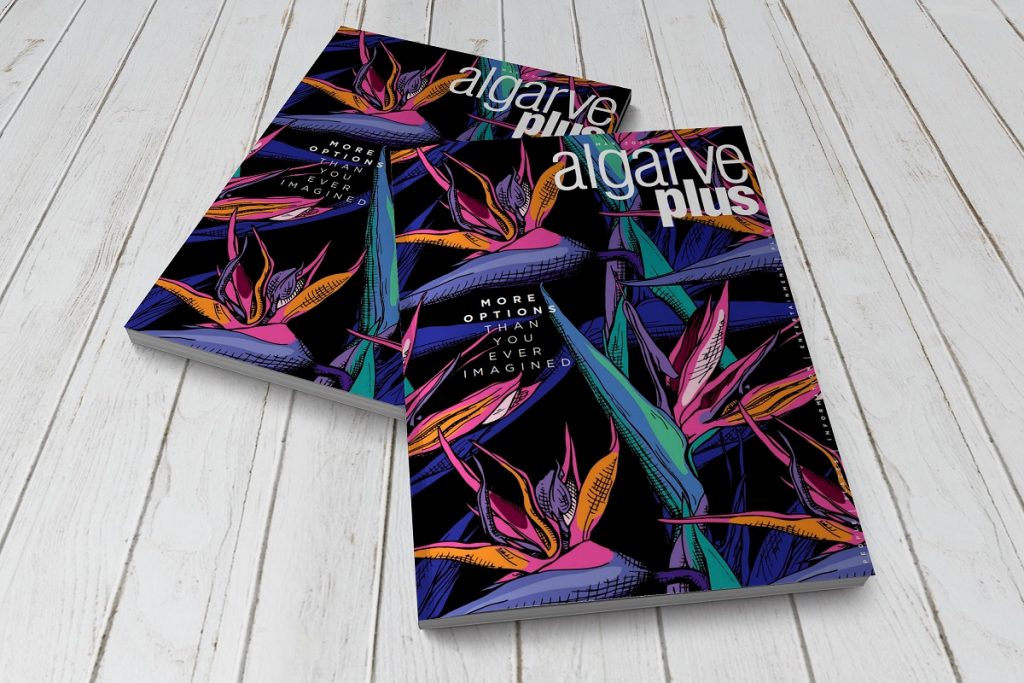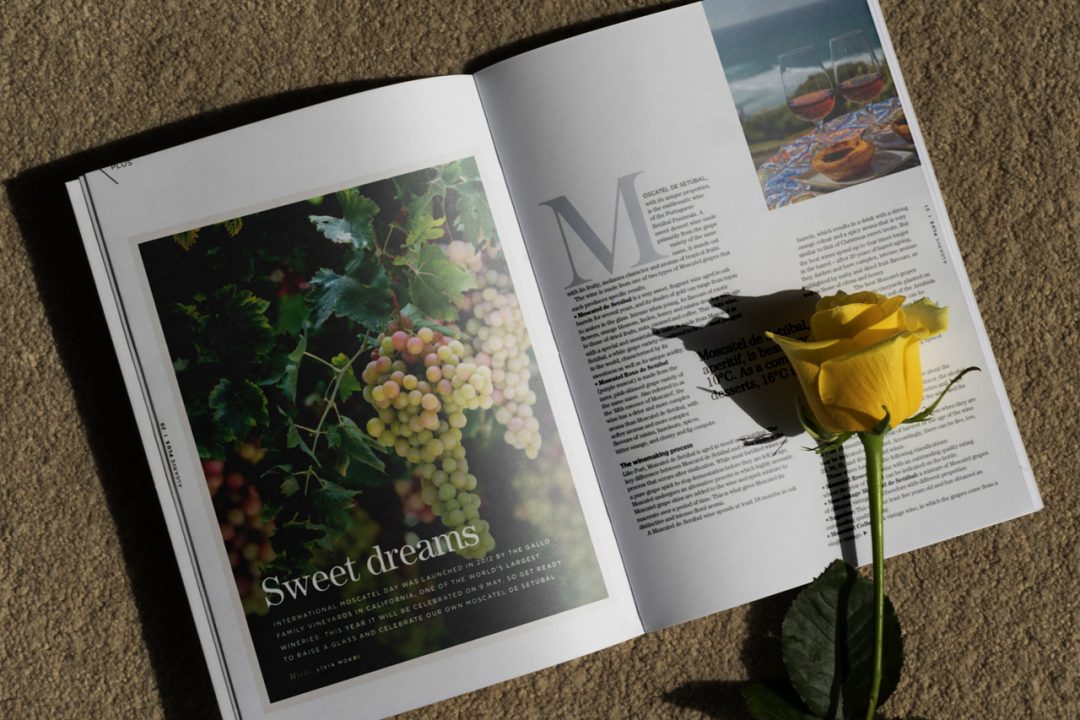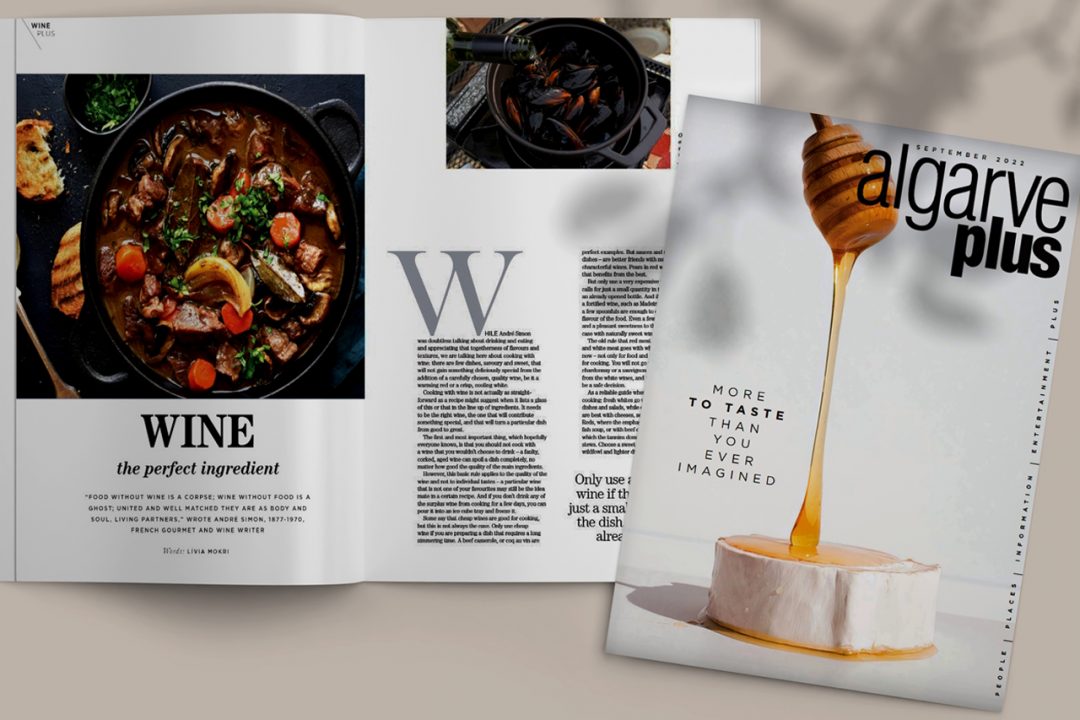Sweet Dreams – International Moscatel Day was launched in 2012 by the Gallo Family Vineyards in California, one of the world’s largest wineries.
This year it will be celebrated on 9 May, so get ready to raise a glass and celebrate Moscatel de Setúbal in Portugal!
I am happy to share that the May issue of the Algarve Plus Magazine has already been published, with my new article!
The magazine is readable online or downloaded for free here.
Enjoy!
Or read here the whole article:
The Sun in a bottle
International Moscatel Day on May 9 is your chance to raise a glass and celebrate the history of this tasty white wine.
The day was created in 2012 by the Gallo Family Vineyards, one of the world’s largest wineries, located in California.
Moscatel de Setúbal, with its unique properties, is the emblematic wine of the wine region of the Portuguese Setúbal Peninsula.
A sweet dessert wine made primarily from the grape variety of the same name, which stands out with its fruity, molasses character and aromas of tropical fruits.
The wine is made from two types of Moscatel grapes, so we get two slightly different drinks.
- Moscatel de Setúbal is a very sweet, fragrant wine aged in oak barrels for several years. Shades of gold can range from topaz to amber in the glass. Intense when young, with aromas of exotic flowers, orange blossom, linden, honey, and raisins, which develop with age into aromas of dried fruits, nuts, caramel, and coffee. This white wine with a special and unmistakable aroma and taste is made from Moscatel de Setúbal, a white grape variety considered to be the most pungent in the world, which is characterized by its sweetness as well as its unique acidity.
- Moscatel Roxo de Setúbal (purple muscat) is made from the rarer, pink-skinned grape variety of the same name. Also referred to as the ‘fifth essence of Moscatel’, the wine has a drier and more complex aroma than Moscatel de Setúbal but is no less rich. It gives more fragrant wines, but in recent years it has been used less and less for winemaking, so we can find it in smaller quantities on the shelves. These wines have similar characteristics to the other muscat variety, but their aromas are softer, with more complex flavors of raisins, hazelnuts, spices, bitter orange, and cherry and fig compote.
Winemaking process
Like Port, Moscatel de Setúbal is aged in wood until bottling. The key difference between Moscatel de Setúbal and other wines is the winemaking process that occurs after vinification. While most fortified wines use a pure grape spirit to stop fermentation before leaving them to age in wooden barrels, Moscatel has an alternative process. Highly aromatic Moscatel grape skins are added to the wine and spirit mixture to macerate over a period of time. This is what gives Moscatel its distinctive floral and intense aroma.
A Moscatel de Setúbal wine spends roughly at least 18 months in oak barrels, which results in a drink with a strong orange color and a spicy, raisin aroma, which is very similar to the smell of Christmas cookies. But the best wines spend up to four times that amount of time in the barrel, giving them a brownish hue. After 20 years of barrel aging, these wines become dark nectar with complex, intense aromas, nutty and dried fruit flavors, as well as citrus and honey. This wine does not develop any further after bottling.
The best Moscatel grapes come from vineyards planted on the limestone soil of the Arrábida Mountains. The wine can be produced from grapes from a single vintage or as a mixture of several vintages. And these wines reach their freshest and fruitiest style when they are 5-6 years old, with strong apricot notes.
Types of Moscatel de Setúbal
The label is an important source of information about the wine, from which we can learn about the geographical origin of the wine, the producer, the alcohol content, the date of the harvest, the grape varieties and, most likely, the indications regarding the production of the wine and the harmonizing notes as well.
Moscatel de Setúbal wines can be marketed from at least one and a half years old. The year of harvest or the age of the wine can be indicated on the label. Accordingly, there can be 5, 10, 20, 30, 35, and 40+ -year-old wines.
These wines have also the following classifications:
- Moscatel Reserva: a wine with an outstanding quality rating where the year of harvest can be indicated on the bottle.
- Non-vintage Moscatel de Setúbal: a mixture of Moscatel grapes of different vintages and therefore different properties.
- Superior: it is at least 5 years old wine that has obtained an outstanding quality rating.
- Moscatel Colheita: vintage wine, in which the grapes come from a single vintage.
Food pairing
Moscatel de Setúbal is not only a dessert wine, but also an aperitif, so it is a good choice with all kinds of dried fruit, even if it is a little salty. Dried fruit aromas are common in older Moscatel wines, especially hazelnuts, walnuts, figs, and raisins. Therefore, any dessert based on these ingredients harmonizes well with wine.
The aromas of orange and orange blossom are the two most commonly found aromas of Moscatel de Setúbal, especially the younger wines. Wines older than 5 years often have the aroma and taste of candied oranges. Therefore, wine can be a good choice for all kinds of orange and citrus desserts.
Because of its strong taste, coffee is usually the “enemy” of wine, so we don’t even recommend drinking it right after an espresso. However, it is a proven fact that coffee-based desserts, such as the famous Portuguese coffee biscuit cake called ‘Bolo de Bolacha’, are a great pairing.
Portugal has a long tradition of the so-called monastery sweets, the main feature of which is that they are made with egg cream. An example is the famous Pastel de Nata. However, only these Moscatel wines can cope with the intense sweetness of these cakes, because it weakens and balances these flavors with the natural acids in the wine, which is essential in fortified wines.
When pairing Moscatel wine with cheese, the acidity and sweetness of the drink are harmonized with the salt in the cheese. Therefore, the saltiest, marinated cheese will be the most appropriate choice. The best example of this is the Azeitão cheese made in the Setúbal region.
Chocolate is also a great pairing for wine. And since the profile of Moscatel is rich, and the cocoa content of the chocolates is also varied, the range of possible harmonizations can be wide. Milk chocolate, for example, harmonizes well with a younger Moscatel, as the acidity of the wine compensates for the sweetness of the chocolate.
Semi-sweet chocolates can also be easily combined with wine. Since Moscatel is a sweet wine by nature, a variety older than 5 years, or Moscatel Roxo, will be the perfect choice for it.
In the case of dark chocolate with a cocoa content of more than 70%, the best pairing is a wine older than 10 years, or also Moscatel Roxo. In this case, any muscat will actually soften the bitterness of the dark chocolate with its sweetness.
The chocolates filled with liqueur, fruit, or nut cream, due to the similarity of the aromas, also harmonize well with Moscatel de Setúbal.
How to consume Moscatel wines?
Moscatel de Setúbal can also be enjoyed as an aperitif. In this case, it is worth serving at 10 °C. If, on the other hand, it is consumed as a complement to desserts, it should be served at 16 °C.
And how you can celebrate International Moscatel Day? Open a bottle of great Portuguese Moscatel wine or create a tasty cocktail in the comfort of your home.

Moscatel cocktail recipes
While some wines don’t really lend themselves to being mixed into drinks, Moscatel’s light and fruity flavors mean that it works super well when made into refreshing coolers. Try out some of these ideas for making delicious beverages that can be enjoyed on International Moscatel Day and all summer long!
Moscatel Tónico
Ingredients for one serving:
- 4cl of Moscatel de Setúbal
- 1cl of Triple Sec
- tonic water
- ½ slice of orange
- 1 cinnamon stick
- orange peel spiral
Pour the Moscatel wine and the Triple Sec into a long drink glass. Add the orange slice and cinnamon stick. Then fill the glass with tonic water. Use a spiral of orange peel for garnish.
Moscatel Sangria
Ingredients for approx. one liter:
- 10cl of Moscatel de Setúbal
- 1/2 bottle of white sparkling wine
- 5cl of vodka
- 2 slices of orange
- 2 slices of lime
- 5cl of lime juice
- 1/2 apple
- 1 cinnamon stick
- 4 mint leaves
- 1/2 liter of 7Up
- ice
Cut the washed fruits into cubes or slices. Mix all the ingredients in a glass jar and stir vigorously. Serve fresh.
Flavored Moscatel
Ingredients for one serving:
- 6cl of Moscatel de Setúbal
- rosemary
- orange zest
- 1 or 2 ice cubes
- dehydrated or fresh orange
Burn the rosemary on a plate and turn an empty whiskey-style glass on top, leaving the base up. Wait 10 seconds and remove the glass. Place the orange zest on the edge of the glass. Pour the Moscatel wine and ice into the glass and mix. Garnish with a slice of fresh orange and a sprig of rosemary.
Ginger Moscatel
Ingredients for one serving:
- 5 cl Moscatel
- ginger ale as taste
- ice cubes
- 2 slices of lemon peel
Put the ice cubes into the glass. Pour the wine on it. Fill the half glass with the ginger ale. Garnish with lemon peels.






No Comments Found